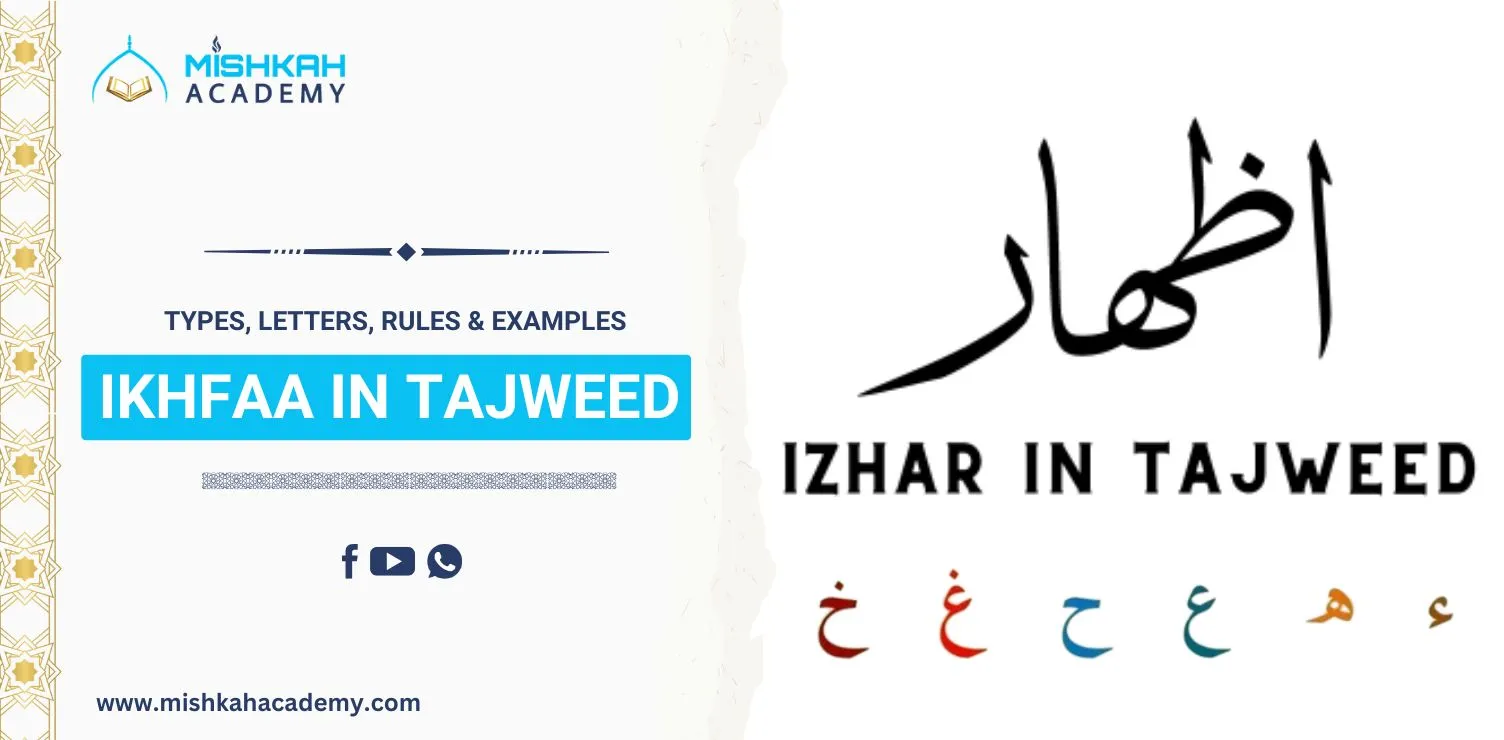In the science of Tajweed, which deals with the guidelines for correctly pronouncing and reciting the Quran, izhar is a crucial idea. An Arabic word called “izhar” signifies “clarity” or “manifestation.” Tajweed has restrictions about how to pronounce some letters, especially the noon sakinah (نْ) and tanween (the double vowels that represent a light “n” sound, transcribed as ً, ٍ, ٌ This article will clarify how to use the Quran’s Izhar rule in recitation by explaining its definition, rules, types, letters, and examples that you can learn in quran tajweed course.
What is Izhar in Tajweed?
Table of Contents
ToggleIzhar (الإظهار) is the norm in Tajweed that calls for the noon sakinah and tanween to be pronounced clearly and differently, without nasalization (ghunnah), merging (idgham), or hidden (ikhfa). The word “Izhar” means “clarity” or “expression,” meaning that the reciter should use the correct articulation to pronounce the sound clearly so that it can be heard without being nasalized or blended with the next letter.
Types of Izhar in Tajweed
Izhar can be classified into two main types based on the application of the rule with specific letters following noon sakinah and tanween:
1:Izhar Halqi (إظهار حلقي)
The most prevalent form of Izhar in Tajweed, this rule is applied when one of the six “halqi” (throat) letters follows noon sakinah or tanween. “Halqi” means “from the throat,” and the throat area is where these letters are made. The main subject of this article is Izhar Halqi.
2:Izhar Mutlaq (الإظهار المطلق
A less common form of Izhar is called Izhar Mutlaq (الإظهار المطلق), which occurs in certain words where midday sakinah appears in the midst of the word without being followed by any of the typical letters connected to ikhfa or idgham. It is largely an exemption to other Tajweed regulations and appears rarely in the Quran.
Note: Enroll in the Advance Tajweed course to learn “Izhar” with expert Egyptian Tajweed tutors.
Start Your Tajweed Learning Journey Today
Izhar Halqi Letters
Izhar Halqi (إظهار حلقي) applies specifically when noon sakinah or tanween is followed by one of the six throat letters (حروف حلقية), which originate from the throat. These six letters are:
- ء (Alif / Hamzah)
- هـ (Ha)
- ع (Ayn)
- ح (Haa)
- غ (Ghayn)
- خ (Kha)
These letters are known as huruf halqiyah (حروف حلقية), meaning “throat letters,” because they are articulated from different areas within the throat.
Rules of Izhar Halqi
The following is how Izhar Halqi’s guidelines are applicable:
- When to Use Izhar: Izhar is used when one of the six throat letters follows noon sakinah or tanween right away.
- Clear Pronunciation: The noon sound should be pronounced clearly, without blending with the next letter or making any nasal sounds.
- No Ghunnah (Nasal Sound): Izhar requires that the noon sound be pronounced clearly and without a protracted nasal sound, in contrast to several other Tajweed rules (such as Idgham and Ikhfa).
Examples of Izhar Halqi
Izhar Halqi occurs when noon sakinah or tanween is followed by any of the six throat letters: ء (Alif/Hamzah), هـ (Ha), ع (Ayn), ح (Haa), غ (Ghayn), خ (Kha).
Examples of Izhar Halqi with Noon Sakinah
- Surah Al-An’am, Ayah 99:
“مِنْ عِنَبٍ”
Here, the noon sakinah (نْ) in “مِنْ” is followed by ع (Ayn), one of the throat letters. The نْ is pronounced clearly without any nasalization or merging, following the rule of Izhar.
Surah Al-Haqqah, Ayah 7:
“وَيَسْبِقُونَ مِنْ حُجُورٍ”
In the phrase, the noon sakinah (نْ) in “مِنْ” is followed by ح (Haa), another throat letter, requiring the noon to be pronounced clearly without ghunnah (nasal sound).
Surah Al-Baqarah, Ayah 257:
“يُخْرِجُهُمْ مِنَ الظُّلُمَاتِ إِلَى النُّورِ”
Here, the noon sakinah (نْ) in “مِنَ” is followed by خ (Kha), one of the throat letters. The نْ is pronounced clearly, adhering to the Izhar rule.
Izhar Mutlaq Examples
Izhar Halqi is more common than Izhar Mutlaq, which is a special kind of Izhar. Izhar is necessary in place of idgham or ikhfa in certain particular places in the Quran where noon sakinah is followed by other letters. The following are the Quranic terms that are most frequently used for Izhar Mutlaq:
Surah Al-Qiyamah, Ayah 1
“نَحْنُ خَلَقْنَاكُمْ”
Surah Al-An’am, Ayah 99
“قِنْوَانٌ”
The pronunciation of these words is clear since they have a noon sakinah without another throat letter or any other letter that would normally create adjustment or nasalization.
Examples of Izhar Mutlaq in the Quran
Surah Yaseen, Ayah 20
“يَنْقَلِبُونَ”
In this word, the noon sakinah (نْ) is followed by ق (Qaf). Here, the نْ is pronounced clearly without any merging or nasalization, applying Izhar Mutlaq.
Surah Al-An’am, Ayah 99
“قِنْوَانٌ”
In the word “قِنْوَانٌ”, the noon sakinah (نْ) is followed by و (Waw). The noon is pronounced clearly without any merging, following the rule of Izhar Mutlaq.
Key Points for Reciters
- Master the Throat Letters: To properly use the rule of Izhar, one must be aware of the six throat letters and be able to identify them in Quranic text.
- Pay Attention to Clarity: Izhar requires clarity, in contrast to other Tajweed regulations. Practice avoiding merging or nasal sounds.
- Remember Typical Examples: Memorizing phrases like “من عنده” or “جزاءً” makes it easier to comprehend and identify Izhar in various situations.
- Practice Frequently: Mastering the application of Izhar can be facilitated by regular quran recitation with a trained instructor or by using verified Tajweed materials.
The Importance of Izhar in Tajweed
The science of Tajweed ensures that the words of the Quran are recited in a way that maintains the correct pronunciation and meaning, preserving the divine nature of the text according to quran reading rules. Applying the rule of Izhar ensures that the recitation remains precise and pure, allowing each letter and sound to be articulated distinctly. By following the rules of Izhar, a reciter fulfills their responsibility to honor the integrity of the Quranic text, making it pleasing to listen to and ensuring that no mistakes in meaning or pronunciation occur.
Conclusion
The fundamental rule of Tajweed, known as izhar, focuses on pronouncing the noon sakinah and tanween clearly when they are followed by any of the six throat letters: ء, هـ, ع, ح, غ, and خ. The clarity and integrity of the Quranic text are preserved when reciters follow Izhar, which guarantees that every sound is produced from its proper location without nasalization or merger. Both the reciter and the listener experience a spiritually joyful event when they understand and apply Izhar, improving the technical excellence of recitation while maintaining the integrity of the heavenly words.






